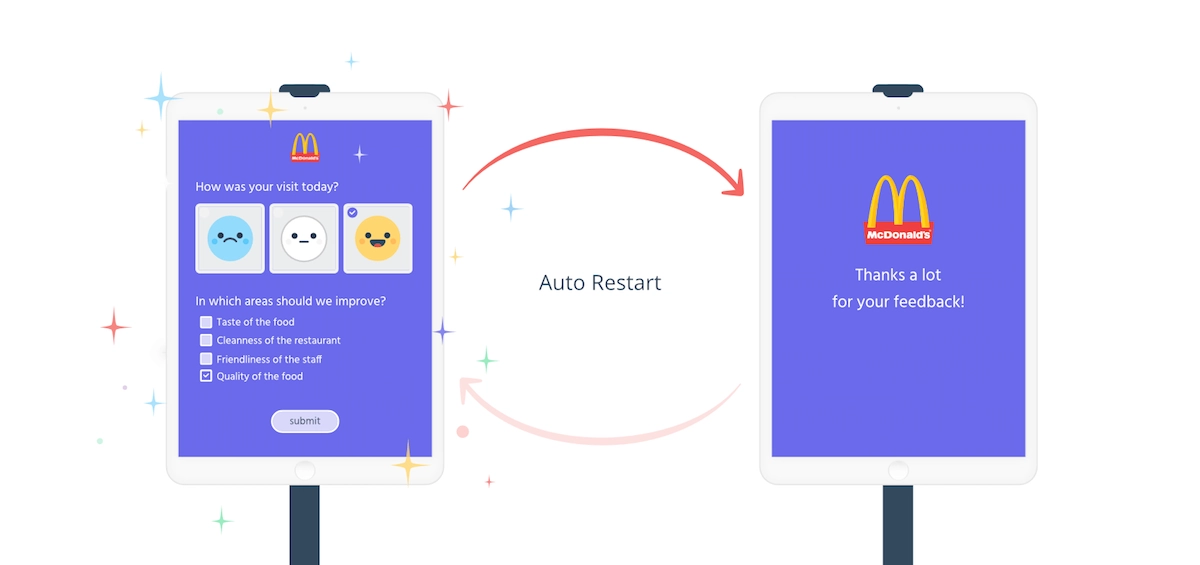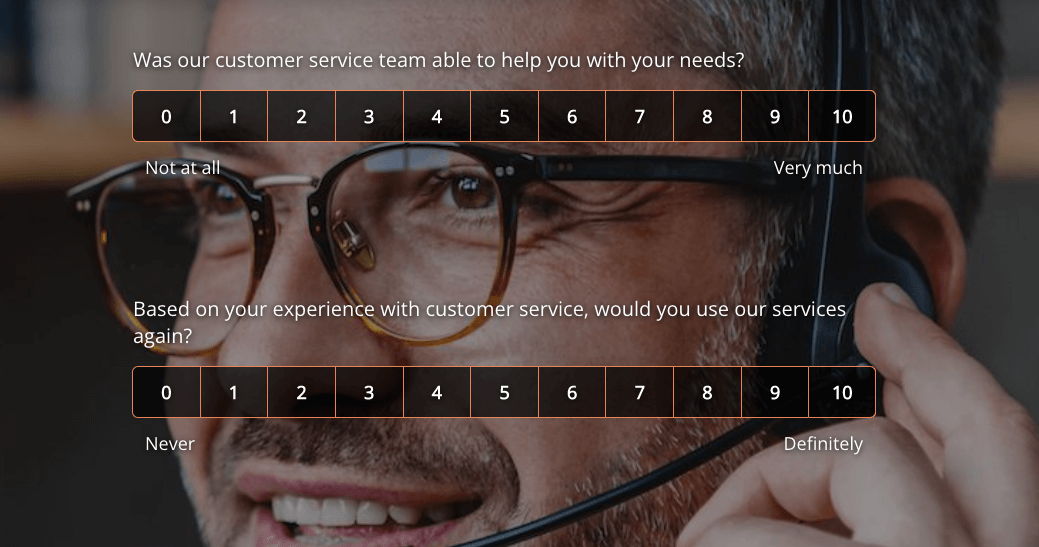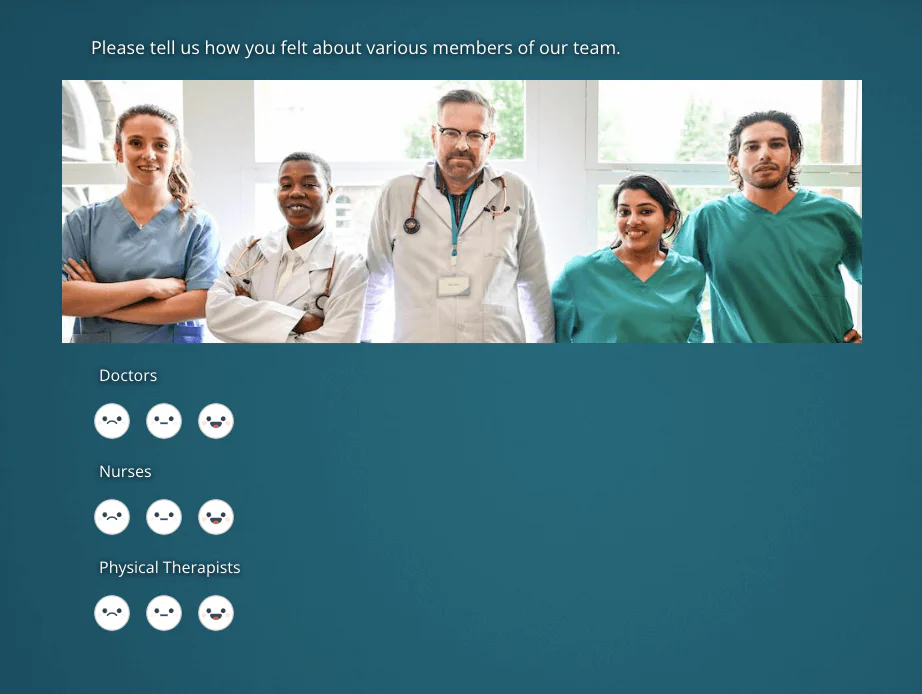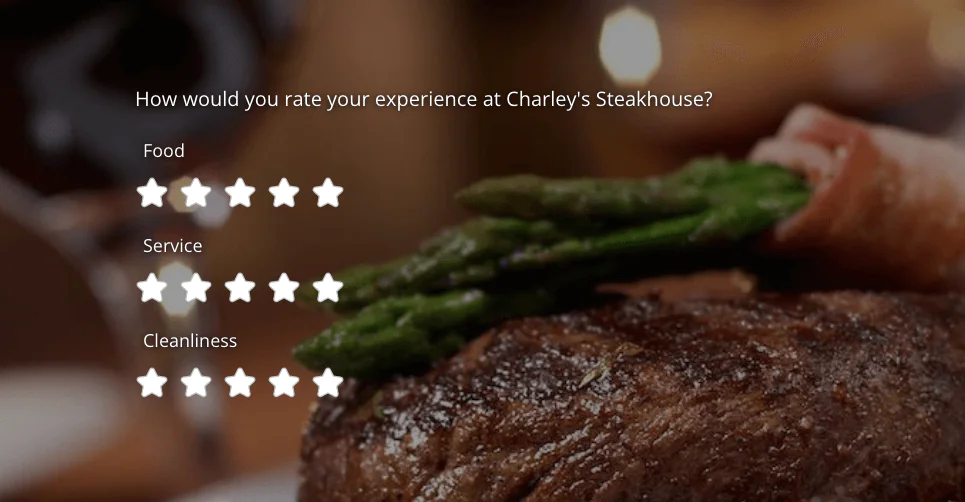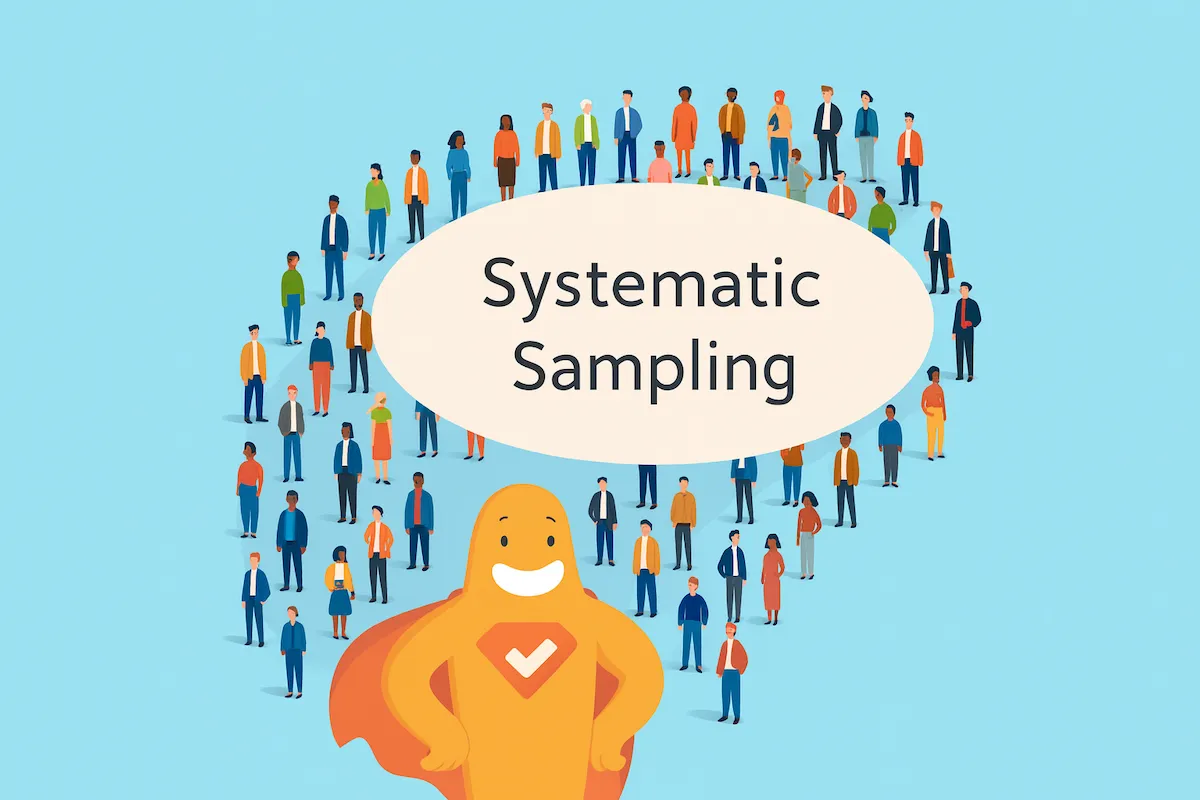Kiosk surveys offer a modern, low-pressure way to collect real-time customer feedback at the point of experience. Touchscreen kiosks placed in high-traffic areas such as exits, registers, or waiting spots encourage higher response rates than delayed email or phone surveys. They’re cost-effective, easy to implement, and produce more accurate data while enabling comparisons across multiple locations. Best practices include keeping surveys short and simple, using rating scales or smiley faces, and adding pictures or emojis to improve understanding and reduce language barriers. By analyzing kiosk survey responses through user-friendly dashboards, businesses can identify trends, improve services, and enhance overall customer satisfaction.
Create your first kiosk survey, form, or poll now!
What is a Kiosk Survey?
A kiosk survey is a touchscreen display device placed in various outlets that asks for feedback, often at the point of purchase. You can find them on tables in restaurants, at the exits of retail stores, and so on. The displays are programmed with a questionnaire that collects feedback and then automatically resets for the next person once the survey has been successfully submitted. Feedback kiosks and interactive kiosks are designed to engage users and collect real-time responses, making them ideal for gathering immediate insights.
For example, let’s say you place a kiosk survey in your bakery. You can enhance the customer experience by creating a customized kiosk device with branding elements such as your logo and brand colors. Your customer notices it on their way out, and the screen reads that customers can be entered for a chance to win a gift card just for completing a quick survey. Always a fan of incentives, the customer takes a few minutes to complete the questionnaire. Often, to keep it simple, questions are based on a rating scale. So on a scale of 1–5, it may ask questions like:
- How was your overall experience today?
- Did you receive fast and friendly service?
- How was the quality of your food or beverage?
- Would you recommend our bakery to a friend?
- How likely would you be to come back again?
Users interact with the kiosk device to provide feedback, ensuring the process is seamless and user-friendly. The customer completes these quick questions, hits submit, and then the kiosk resets for the next person. In very little time, you’ll have built up quite a database of information!
Six Benefits of Using Kiosk Surveys
Yes, customers may be in a hurry and not complete a kiosk survey. And occasionally, the touchscreen could freeze up. But overall, the advantages of kiosk surveys far outweigh these negatives. Kiosk surveys offer tailored solutions to meet specific business needs and provide valuable services for collecting feedback. Here’s a quick look at the pros of using a survey kiosk for your business.
Create your first kiosk survey, form, or poll now!
1. No Pressure on Respondents
People typically don’t like to be pressured into taking a survey, so an in-person intercept interview may turn them off. While in-person feedback can be valuable for collecting immediate, real-time insights, feedback kiosks provide a less intrusive alternative. However, a standalone kiosk survey is a passive experience; they can choose to complete a survey or walk away.
2. Cost-Effective
Hiring an interviewer to collect responses in-store through an intercept interview can get expensive if you intend to conduct surveys frequently. A kiosk may have an initial small investment, but in time, it will have paid for itself through feedback collection.
3. More Accurate Feedback
If you wait to collect feedback through an email or phone survey, there’s a good chance the person won’t have a great recollection of their experience. So, you may not get the most accurate answers. Using a kiosk survey, you collect feedback while the experience is still fresh in consumers’ minds, enabling real-time feedback collection.
4. High Volume of Responses
It’s easy to delete an email or hang up after a customer service call without taking the survey. Survey kiosks tend to get a better response, and placing them in high-traffic areas can lead to more responses because people can take the survey while they’re waiting for their order, waiting for a friend to arrive, and so on. High traffic areas are ideal for maximizing the number of responses collected.
5. Easy Implementation
Kiosks are easy to set up and require little maintenance. Internet access is no longer an issue as most businesses now have reliable Wi-Fi, but it’s important to ensure a reliable internet connection for seamless data syncing and operation. Without the need to hardwire equipment, today’s kiosks are cloud-based, making them easy to implement.
6. Unique Data Collection
Last but not least, if you have multiple locations, you can collect data for each location and each site, allowing for comprehensive analysis and comparison, while some locations or sites get high marks and others do not. The ability to set benchmarks for locations then becomes very easy.
Create your first kiosk survey, form, or poll now!
Setting Up a Customer Feedback Kiosk
Setting up a customer feedback kiosk is a crucial step in ensuring you collect meaningful and actionable feedback from your customers. The right setup not only encourages more responses but also helps you gather real-time feedback that can drive improvements in customer satisfaction and overall experience.
Choosing the Right Location
Selecting the optimal location for your customer feedback kiosk can make all the difference in the volume and quality of feedback you receive. To maximize participation, place your feedback kiosk in high-traffic areas where customers naturally pass by or spend time. Retail stores, restaurants, and service businesses often see the best results when kiosks are positioned near exits, entrances, or waiting areas—places where customers are most likely to reflect on their experience and provide instant feedback.
Visibility and accessibility are key. Your kiosk should be easy to spot and simple for anyone to use, with clear instructions and a user-friendly platform. This not only increases your response rate but also ensures that the feedback you collect is representative of your customer base. Make sure the kiosk is placed in an area with a reliable internet connection to enable real-time feedback collection and auto-sync of survey responses. For locations where Wi-Fi may be inconsistent, choose a device that supports offline mode, so you never miss valuable insights even if the connection drops temporarily.
A well-placed feedback kiosk should feature intuitive feedback forms, such as smiley face ratings, Likert scales, and follow-up questions, making it easy for customers to share their thoughts quickly. The ability to collect data instantly and compare feedback across different locations or time periods gives businesses a powerful tool for identifying areas of improvement and tracking customer satisfaction metrics like net promoter score.
Create your first kiosk survey, form, or poll now!
Tips for Kiosk Survey Questions
When you’re ready to create your kiosk survey questions, there are a few good habits to keep in mind. Including follow-up questions based on initial responses is important for gaining deeper and more actionable insights from your customers.
Keep It Short
People become disengaged when surveys go on and on or seem to ask repetitive questions. So, keep your survey as short as possible (especially if it’s a stand-up kiosk). We recommend keeping surveys to about five questions so that they shouldn’t take more than a minute or two to complete.
Keep It Simple
Asking people to type out answers will result in some dropping out. So, as mentioned, use a rating scale or yes/no questions, or consider smiley face ratings for quick and easy feedback. You might want to include an open-ended question for “additional comments” if participants are so inclined.
Include Survey Pictures
Pictures can really improve the look of your surveys and reduce language barriers. Depending on the type of business, a survey kiosk with pictures is a great choice. You might also consider a kiosk survey with emojis, once again making it easy for participants to understand and complete.
Place Kiosk Surveys at “Bottlenecks”
To collect the most feedback, place kiosk surveys in places where people tend to get held up, such as doorways, registers, and other high-traffic locations, to maximize survey participation. This will also help them get noticed (some signage doesn’t hurt, either)!
Kiosk Survey Examples
Below is an example of a survey with pictures created using SurveyLegend. A rating scale also makes it simple for respondents to complete.
Here’s another kiosk survey example for a medical facility. This survey with emojis also includes a large photo.
Lastly, this next example is for a restaurant. It uses star ratings, which were popularized for restaurants due to Zagat.
By analyzing the results from these surveys, you can identify areas of the customer experience that need improvement.
Create your first kiosk survey, form, or poll now!
Here’s another kiosk survey example for a medical facility. This survey with emojis also includes a large photo.
Lastly, this next example is for a restaurant. It uses star ratings which were popularized for restaurants due to Zagat.
Analyzing Feedback for Actionable Insights
Collecting customer feedback through kiosk surveys is just the first step—analyzing that feedback is where the real value lies. To truly improve customer satisfaction and enhance the overall experience, businesses need to turn raw survey responses into actionable insights. Analyzing kiosk survey data provides valuable insight into customer preferences and behaviors, enabling businesses to better understand what drives satisfaction and loyalty.
A key part of this process is ensuring that your feedback kiosk survey responses are reliably collected and synced. Using a feedback kiosk with a stable internet connection allows for real-time data transfer, so you never miss a response. For locations where internet access may be spotty, many modern kiosks offer offline mode, automatically syncing data once a connection is restored. This ensures that every piece of feedback is captured and ready for analysis.
Once your data is collected, a user-friendly platform makes it easy to manage and analyze responses. With intuitive dashboards and reporting tools, businesses can quickly identify trends, spot areas for improvement, and compare feedback across different locations or time periods. This streamlined data collection and analysis process helps you gain valuable insights into what your customers love—and where you can do better.
By regularly reviewing kiosk survey data, you can make informed decisions that lead to happier customers and a stronger brand. Whether it’s adjusting your service, updating your offerings, or recognizing top-performing employees, analyzing feedback empowers your business to take meaningful action and continually improve the customer experience.
Conclusion
Kiosk surveys are a great way to collect customer feedback for real-time insights, providing real-time insights and enabling immediate action based on customer responses while the experience is still fresh in their minds. If you’re considering one of these displays for your business, you can’t go wrong with SurveyLegend. Our surveys with pictures render beautifully on any device, and they’re easy to create. Auto sync functionality ensures that any feedback collected offline is automatically uploaded when the device reconnects, so no data is lost. Actionable feedback from kiosk surveys can be used to make quick improvements to your service or operations. Get started today or learn more about our kiosk surveys.
Have you considered a survey kiosk for your business? How much more feedback do you think you could get? Let us know your thoughts in the comments!
Create your first kiosk survey, form, or poll now!
Frequently Asked Questions (FAQs)
What is a kiosk survey?
Kiosk surveys can usually be found at businesses that value customer feedback. These touchscreen kiosks can usually be found at the point of sale or exit. Users interact with the touchscreen to provide their feedback.
What is the biggest advantage of a kiosk survey?
The ability to get customer feedback during or immediately following their experience is the biggest benefit. The experience is still fresh in their mind, and their feedback is likely to be more accurate.
Are there any negatives to using a kiosk survey?
The only drawback is the potential for technical difficulties, but these can usually be resolved easily.
